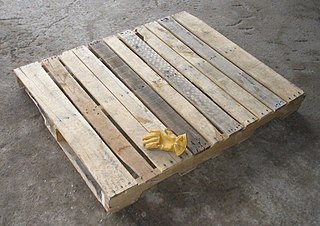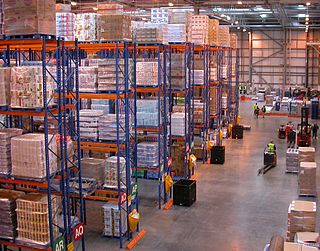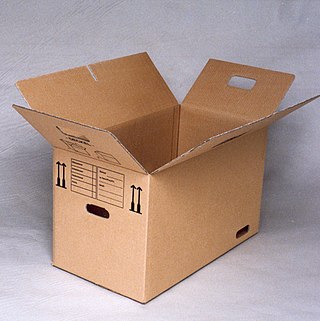Related Research Articles

In transportation, freight refers to goods conveyed by land, water or air, while cargo refers specifically to freight when conveyed via water or air. In economics, freight refers to goods transported at a freight rate for commercial gain. The term cargo is also used in case of goods in the cold-chain, because the perishable inventory is always in transit towards a final end-use, even when it is held in cold storage or other similar climate-controlled facilities, including warehouses.

Packaging is the science, art and technology of enclosing or protecting products for distribution, storage, sale, and use. Packaging also refers to the process of designing, evaluating, and producing packages. Packaging can be described as a coordinated system of preparing goods for transport, warehousing, logistics, sale, and end use. Packaging contains, protects, preserves, transports, informs, and sells. In many countries it is fully integrated into government, business, institutional, industrial, and for personal use.

A drum is a cylindrical shipping container used for shipping bulk cargo. Drums can be made of steel, dense paperboard, or plastic, and are generally used for the transportation and storage of liquids and powders. Drums are often stackable, and have dimensions designed for efficient warehouse and logistics use. This type of packaging is frequently certified for transporting dangerous goods. Proper shipment requires the drum to comply with all applicable regulations.

A pallet is a flat transport structure, which supports goods in a stable fashion while being lifted by a forklift, a pallet jack, a front loader, a jacking device, or an erect crane. Many pallets can handle a load of 1,000 kg (2,200 lb). While most pallets are wooden, pallets can also be made of plastic, metal, paper, and recycled materials.

A Slip sheet is “a corrugated, solid fiber, or plastic sheet onto which a unit load can be assembled. A protruding short panel can be grasped by the jaws of a pull-pack truck and the load pulled back onto the pull-pack platform.”

A distribution center for a set of products is a warehouse or other specialized building, often with refrigeration or air conditioning, which is stocked with products (goods) to be redistributed to retailers, to wholesalers, or directly to consumers. A distribution center is a principal part, the order processing element, of the entire order fulfillment process. Distribution centers are usually thought of as being demand driven. A distribution center can also be called a warehouse, a DC, a fulfillment center, a cross-dock facility, a bulk break center, and a package handling center. The name by which the distribution center is known is commonly based on the purpose of the operation. For example, a "retail distribution center" normally distributes goods to retail stores, an "order fulfillment center" commonly distributes goods directly to consumers, and a cross-dock facility stores little or no product but distributes goods to other destinations.

Strapping, also known as bundling and banding, is the process of applying a strap to an item to combine, stabilize, hold, reinforce, or fasten it. A strap may also be referred to as strapping. Strapping is most commonly used in the packaging industry.
Truckload shipping is the movement of large amounts of homogeneous cargo, generally the amount necessary to fill an entire semi-trailer or intermodal container. A truckload carrier is a trucking company that generally contracts an entire trailer-load to a single customer. This is as opposed to a less-than truckload (LTL) company that generally mixes freight from several customers in each trailer. One advantage Full Truckload (FTL) carriers have over Less than Truckload carriers is that the freight is never handled en route, whereas an LTL shipment will typically be transported on several different trailers. Truckload shipments are typically run on 48' or 53'dry van trailers which will hold 24 or 26 pallets respectively.

Less-than-truckload shipping or less than load (LTL) is the transportation of an amount of freight sized between individual parcels and full truckloads. Parcel carriers handle small packages and freight that can be broken down into units less than approximately 150 pounds (68 kg). Full truckload carriers move entire semi-trailers. Semi-trailers are typically between 26 and 53 feet and require a substantial amount of freight to make such transportation economical. The term LTL can refer to the freight itself, or to the carrier that transports the such freight.

Intermediate bulk containers are industrial-grade containers engineered for the mass handling, transport, and storage of liquids, semi-solids, pastes, or solids. The two main categories of IBC tanks are flexible IBCs and rigid IBCs. Many IBCs are reused or repurposed.

Material handling equipment (MHE) is mechanical equipment used for the movement, storage, control, and protection of materials, goods and products throughout the process of manufacturing, distribution, consumption, and disposal. The different types of equipment can be classified into four major categories: transport equipment, positioning equipment, unit load formation equipment, and storage equipment.

Package pilferage is the theft of part of the contents of a package. It may also include theft of the contents but leaving the package, perhaps resealed with bogus contents. Small packages can be pilfered from a larger package such as a shipping container. Broader and related aspects of package theft may include taking the entire package, pallet load, truck load, shoplifting, etc. The theft may take place at any point in the parcel's journey from source to destination, including theft by rogue logistics employees and customs agents in international mail scenarios.

A bulk box, also known as a bulk bin, skid box, pallet box, bin box, gaylord, or octabin, is a pallet-size box used for storage and shipping of bulk quantities.

Stretch wrap or stretch film, sometimes known as pallet wrap, is a highly stretchable plastic film that is wrapped around items. The elastic recovery keeps the items tightly bound. In contrast, shrink wrap is applied loosely around an item and shrinks tightly with heat. While it is similar to plastic food wrap, it is not usually made of material rated as safe for food contact.

The term unit load refers to the size of an assemblage into which a number of individual items are combined for ease of storage and handling, for example a pallet load represents a unit load which can be moved easily with a pallet jack or forklift truck, or a container load represents a unit for shipping purposes. A unit load can be packed tightly into a warehouse rack, intermodal container, truck or boxcars, yet can be easily broken apart at a distribution point, usually a distribution center, wholesaler, or retail store for sale to consumers or for use.

In shipping, break-bulk, breakbulk, or break bulk cargo, also called general cargo, is goods that are stowed on board ship in individually counted units. Traditionally, the large numbers of items are recorded on distinct bills of lading that list them by different commodities. This is in contrast to cargo stowed in modern intermodal containers as well as bulk cargo, which goes directly, unpackaged and in large quantities, into a ship's hold(s), measured by volume or weight.
A shipping container is a container with strength suitable to withstand shipment, storage, and handling. Shipping containers range from large reusable steel boxes used for intermodal shipments to the ubiquitous corrugated boxes. In the context of international shipping trade, "container" or "shipping container" is virtually synonymous with "intermodal freight container", a container designed to be moved from one mode of transport to another without unloading and reloading.

Corrugated box design is the process of matching design factors for corrugated fiberboard boxes with the functional physical, processing and end-use requirements. Packaging engineers work to meet the performance requirements of a box while controlling total costs throughout the system. Corrugated boxes are shipping containers used for transport packaging and have important functional and economic considerations.

Package testing or packaging testing involves the measurement of a characteristic or property involved with packaging. This includes packaging materials, packaging components, primary packages, shipping containers, and unit loads, as well as the associated processes.

Shelf-ready packaging (SRP) and retail-ready packaging (RRP) refers to the packaging of a product so that it is delivered to a retailer in packaging which is optimized for efficient stocking and sale.
References
- ↑ "Pallet Inverter Operation and Guarding", MHI, 2021, retrieved 8 March 2021
- ↑ US 2769557,Ohr, Norman T.,"Skid inverter",published 1956-11-06, assigned to Rutherford Press Inc.
- ↑ US 4295776,Payne, Alan&Bunning, Robin G.,"Portable inverter for transferring bulk goods between pallets",published 1981-10-20